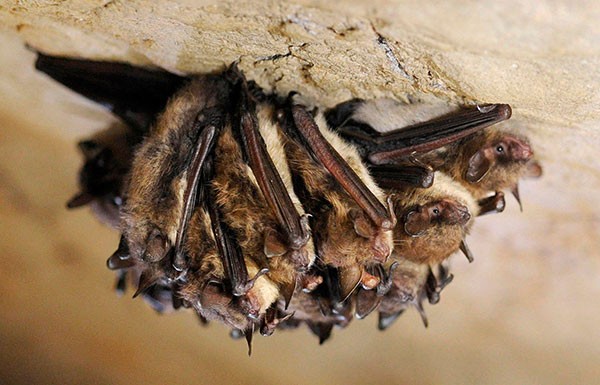Hello Nature readers, would you like to get this Briefing in your inbox free every day? Sign up here.
Little brown bats (Myotis lucifugus) are among those species threatened by white nose syndrome, caused by the fungus Pseudogymnoascus destructans (Credit: Amy Smotherman Burgess/Knoxville News Sentinel via AP/Alamy)
Bat loss linked to death of human babies
When insect-eating bats are wiped out by ‘white nose syndrome’, farmers turn to pesticides for pest control — possibly leading to knock-on effects for human health. Researchers compared counties in the northeastern United States where the white nose fungus had killed most bats to those areas where the disease hadn’t yet spread. In places where bat populations had crashed, farmers used 31% more insecticides and infant deaths not due to accidents or homicides rose by 8% — numbers that the authors suggest might be linked. Where bats remained, there was no change in pesticide use or infant mortality.
Science | 4 min read
Reference: Science paper
Dye makes mice transparent
A dye that helps to give Doritos their orange colour can also turn mouse tissues transparent. Applying the dye to the skin of live mice allowed scientists to peer through tissues at structures such as blood vessels and internal organs without any surgery, incisions, or damage to the mouse’s bone or skin. The reversible technique works by changing how tissue interacts with light, and could offer a less-invasive method of monitoring live animals used in medical research. “It’s a major breakthrough,” says biologist Philipp Keller.
Nature | 4 min read
Reference: Science paper
Image of the week
NASA
NASA’s prototype solar sail has successfully spread its wings in space — and sent back its first selfie. In this black-and-white image, the shiny material of the sail is visible, stretched out on booms. The top of the image shows its reflection in the back of a solar panel. Where a sail would harness the wind on Earth, the Advanced Composite Solar Sail System is pushed by the pressure of solar radiation. (Space.com | 5 min read)
Features & opinion
A day in the life of a supercomputer
Frontier is the fastest supercomputer in the world. Nestled in the hills of Tennessee, it’s been churning through data at record speed since 2022, outpacing 100,000 laptops working simultaneously. Researchers from across the world log in to Frontier with one purpose — to push the bounds of human knowledge. Frontier’s successor, Discovery, is already in the works, but supercomputers consume a lot of energy, and future machines are likely to need even more.
Nature | 12 min read
‘Candidate 1143172: Junior pot scrubber’
Read between the lines of a job application for the most junior role on an intergalactic voyage in the latest short story for Nature’s Futures series.
Nature | 6 min read
Forests are more than trees
In his new book Treewilding, microbial ecologist Jake Robinson questions whether just planting trees is the solution to deforestation. He speaks to Forrest Fleischman, a scholar of forest and environmental policy, who “proposes that people should not just plant trees but ‘grow’ them,” writes biologist and writer Debraj Manna in his review of the book. “This means knowing what species suit an area and how they are connected to the lives of the local people and wildlife.”
Nature | 6 min read
Podcast: ‘Nuclear clocks’ almost ticking
Researchers have made a big step towards the creation of the first nuclear clock by making the most accurate measurement of the frequency of light required to push thorium nuclei into a higher energy state. The ‘tick’ of a future nuclear clock would correspond to the energy transitions of protons and neutrons, potentially making them more precise and robust than atomic clocks, which use electrons. “I actually felt a little doubtful about the signal because we failed so many times,” says physicist Chuankun Zhang. “We spent the entire night doing all the tests to check if this is actually really the signal that we’re looking for. Finally we were able to confirm that, so it was a great relief for me.”
Nature Podcast | 31 min listen
Subscribe to the Nature Podcast on Apple Podcasts, Spotify or YouTube Music, or use the RSS feed.
